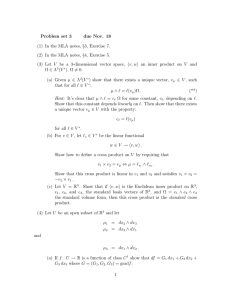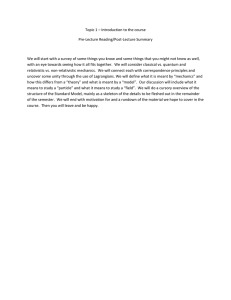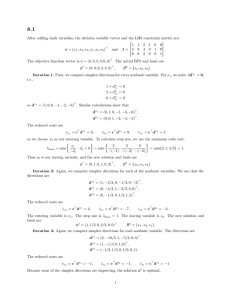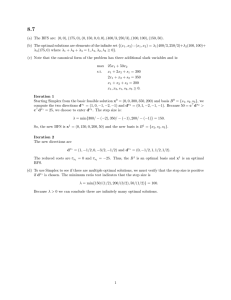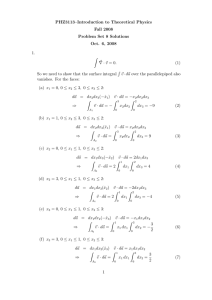8.324 MIT OpenCourseWare Lecture Notes Hong Liu, Fall 2010 Lecture
advertisement
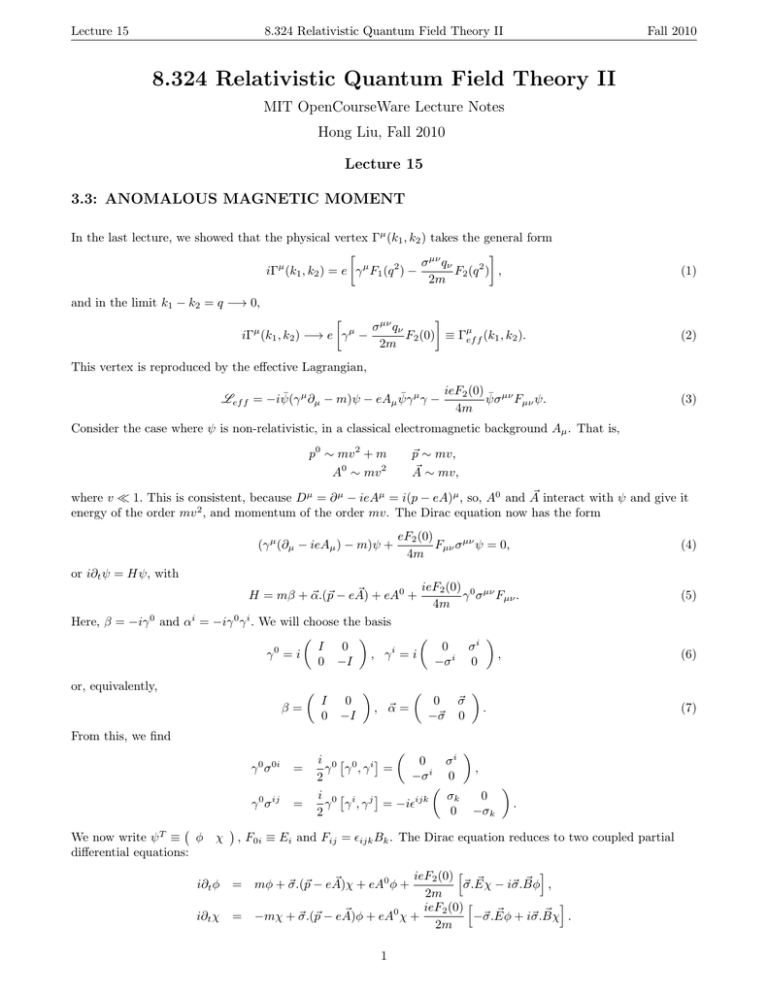
Lecture 15 8.324 Relativistic Quantum Field Theory II Fall 2010 8.324 Relativistic Quantum Field Theory II MIT OpenCourseWare Lecture Notes Hong Liu, Fall 2010 Lecture 15 3.3: ANOMALOUS MAGNETIC MOMENT In the last lecture, we showed that the physical vertex Γµ (k1 , k2 ) takes the general form [ ] σ µν qν iΓµ (k1 , k2 ) = e γ µ F1 (q 2 ) − F2 (q 2 ) , 2m (1) and in the limit k1 − k2 = q −→ 0, [ ] σ µν qν iΓµ (k1 , k2 ) −→ e γ µ − F2 (0) ≡ Γµef f (k1 , k2 ). 2m (2) This vertex is reproduced by the effective Lagrangian, ¯ µ γ − ieF2 (0) ψσ ¯ µν Fµν ψ. Lef f = −iψ̄(γ µ ∂µ − m)ψ − eAµ ψγ 4m (3) Consider the case where ψ is non-relativistic, in a classical electromagnetic background Aµ . That is, p0 ∼ mv 2 + m p⃗ ∼ mv, ⃗ ∼ mv, A A0 ∼ mv 2 ⃗ interact with ψ and give it where v ≪ 1. This is consistent, because Dµ = ∂ µ − ieAµ = i(p − eA)µ , so, A0 and A 2 energy of the order mv , and momentum of the order mv. The Dirac equation now has the form (γ µ (∂µ − ieAµ ) − m)ψ + eF2 (0) Fµν σ µν ψ = 0, 4m (4) or i∂t ψ = Hψ, with ⃗ ) + eA0 + ieF2 (0) γ 0 σ µν Fµν . H = mβ + α.(⃗ ⃗ p − eA 4m Here, β = −iγ 0 and αi = −iγ 0 γ i . We will choose the basis ( ) ( ) I 0 0 σi 0 i γ =i , γ =i , 0 −I −σ i 0 or, equivalently, ( β= I 0 0 −I ) ( , α ⃗= 0 −⃗σ ⃗σ 0 = γ 0 σ ij = ( i 0 [ 0 i] 0 γ γ ,γ = −σ i 2 ( i 0 [ i j] γ γ , γ = −iϵijk 2 σi 0 σk 0 . (7) ) , 0 −σk ) . ( ) We now write ψ T ≡ ϕ χ , F0i ≡ Ei and Fij = ϵijk Bk . The Dirac equation reduces to two coupled partial differential equations: [ ] ⃗ − i⃗σ .Bϕ ⃗ , ⃗ + eA0 ϕ + ieF2 (0) ⃗σ .Eχ i∂t ϕ = mϕ + ⃗σ .(⃗ p − eA)χ 2m [ ] ieF 2 (0) ⃗ + eA0 χ + ⃗ + i⃗σ .Bχ ⃗ . p − eA)ϕ −⃗σ .Eϕ i∂t χ = −mχ + ⃗σ .(⃗ 2m 1 (6) ) From this, we find γ 0 σ 0i (5) Lecture 15 8.324 Relativistic Quantum Field Theory II Fall 2010 [ ] We now let ϕ = e−imt Φ, χ = e−imt X. As i∂t ψ ∼ m + O(mv 2 ) ψ, Φ and X describe fluctuations with ∆E ∼ mv 2 . In terms of these fields, taking the limit v −→ 0, the equations reduce to ] ieF2 (0) [ ⃗ + O(v 3 ), −i⃗σ.Bϕ 2m −2mX + ⃗σ .⃗π Φ + O(v 2 ), i∂t Φ = ⃗σ.⃗πX + eA0 Φ + 0 = ⃗ , and so, solving the second equation for X, and inserting the result into the first equation, we where ⃗π = p⃗ − eA obtain X = i∂t Φ = 1 ⃗σ .⃗π Φ, 2m 1 eF2 (0) ⃗ (⃗σ .⃗π )2 Φ + eA0 Φ + ⃗σ .B Φ. 2m 2m Now, ⃗ (⃗σ .⃗π )2 = σi σj π i π j = (δij + iϵijk σk )π i π j = π 2 + e⃗σ .B, (8) [ i j] ij as π , π = −ieF = −ieϵijk Bk , and so we arrive at the following time-evolution equation in the limit v −→ 0: [ ] 1 e 2 0 ⃗ ⃗ i∂t Φ = (p⃗ − eA) + eA + (1 + F2 (0))⃗σ .B Φ. (9) 2m 2m We recognise the first two terms as the kinetic energy of a particle in an electromagnetic field and the electrostatic potential energy, respectively, and the third term takes the form of a magnetic interaction, ⃗ Hmag = −⃗ µ.B, with µ ⃗ =− e ⃗σ ⃗ 2(1 + F2 (0)) = γ S, 2 2m (10) (11) ⃗ = ⃗σ the spin, and γ = e g the gyromagnetic ratio. Classically, we expect g = 1, and in the Dirac equation with S 2 2m of quantum mechanics, we find g = 2. We see that in the case of quantum electrodynamics, we have g = 2 + 2F2 (0). The additional term of 2F2 (0) is known as the anomalous magnetic moment. We will now explicitly compute the lowest order correction to the magnetic moment. 3.3.1: One-loop correction to the magnetic moment To lowest order, the correction to the physical vertex function is given by k2 Γµ1 (k1 , k2 ) ≡ k2 + l q µ l k1 + l k1 ˆ = (−ie) where S0 (k) = /−m −ik k2 +m2 −iϵ (0) and Dµν = −igµ� l2 −iϵ . ˆ Γµ1 (k1 , k2 ) 3 2 = (−ie) (−1) (−i) 3 d4 l ρ (0) γ S0 (k2 + l)γ µ S0 (k1 + l)γ ν Dνρ (l), (2π)4 (12) Explicitly, we have [ ] [ ] γ ρ i(k/2 + /l) + m γ µ i(k/1 + /l) + m γ ν d4 l . (2π)4 ((k1 + l)2 + m2 − iϵ) ((k2 + l)2 + m2 − iϵ) ((l2 − iϵ) We can combine the denominators using the Feynman trick, ˆ 1 ˆ 1 ˆ 1 1 2 = dx1 dx2 dx3 δ(x1 + x2 + x3 − 1) 3, A1 A2 A3 (x1 A1 + x2 A2 + x3 A3 ) 0 0 0 2 (13) (14) Lecture 15 8.324 Relativistic Quantum Field Theory II Fall 2010 reducing our result for Γµ1 to ˆ ˆ 1 Γµ1 = 2e3 dx1 0 ˆ 1 0 1 dx3 δ(x1 + x2 + x3 − 1) dx2 0 Nµ , D3 (15) where N µ ≡ γ ν [i(k/2 + l) + m] γ µ [i(k/1 + l) + m] γν , (16) and D [ ] [ ] ≡ x1 (k/1 + l)2 + m2 + x2 (k/2 + l)2 + m2 + x3 l2 − iϵ = (l + x1 k1 + x2 k2 )2 + x1 (1 − x1 )k12 + x2 (1 − x2 )k22 − 2x1 x2 k1 .k2 + (x1 + x2 )m2 − iϵ. We may shift the variable in the integral l −→ p = l + x1 k1 + x2 k2 , and rewrite the result in terms of q 2 instead of k1 .k2 , giving D = p2 + x1 x2 q 2 + (x1 + x2 )2 m2 − iϵ. (17) Further, [ ] µ[ ] = γ ν i(p / − x1 k/1 + (1 − x2 )k/2 ) + m γ i(p / + (1 − x1 )k/1 + x2 k/2 ) + m γν µ ν µ = −γ ν p /γ p /γν + γ [i(x1 k/1 + (1 − x2 )k/2 ) + m] γ [i((1 − x1 )k/1 + x2 k/2 ) + m] γν +terms linear in p. Nµ The terms linear in p evaluate to zero in the integral, as they are odd, so we can discard them. The first term can be evaluated using the identity γ ν a //b/cγν = −2a //b/c, resulting in µ µ µ 2 µ ν µ −γ ν pγ /p = −2p γ + 4p p γν . / pγ / ν = −2p /pγ / + 4p This last term is again odd in the individual components of the momentum integral, and so reduces to inside the integral. So, the contribution to the integrand from the first term is (18) p2 g �µ 4 γν −p2 γ µ . (19) We see that this term contributes to F1 , and we know by the Ward identity that F1 (0) is zero. We can disregard this term here. The second term is p−independent, convergent in the ultraviolet, and contains a contribution to F2 . We use the identities γ ν γ α γ β γν = 4g αβ , = −2γ α , γ ν γ α γν and so the relevant contribution to N µ is Nµ = −2 [−ix2 k/2 + i(1 − x1 )k/1 ] γ µ [−ix1 k/1 + i(1 − x2 )k/2 ] +4m [i(1 − 2x1 )k1µ + i(1 − 2x2 )k2µ ] − 2m2 γ µ . We discard the last term, which again contributes to F1 . We again use the fact that Γµ appears in the combination ū(k2 )Γµ u(k1 ) for on-shell spinors, and that ūk/2 = −imu, ¯ k/1 u = −imu, for on-shell solutions. So, the relevant part of N µ in the integrand can be written as Nµ = −2 [−x2 m + i(1 − x1 )k/1 ] γ µ [−x1 m + i(1 − x2 )k/2 ] +4im [(1 − 2x1 )k1µ + (1 − 2xx )k2µ ] . / µ = −γ µ k/ + 2k µ , and again retaining only the parts contributing to F2 , the relevant part of Using the identity kγ µ N reduces finally to N µ = 2im(x1 + x2 )(1 − x1 − x2 )(k1µ + k2µ ). (20) Thus, we find Γµ1 = γ µ (. . .) + (k1µ + k2µ )B, with ˆ 1 ˆ 1 ˆ ˆ 1 dx1 dx2 dx3 δ(x1 + x2 + x3 − 1) 3 B = 2e 0 0 0 3 d4 p 2im(x1 + x2 )(1 − x1 − x2 ) . 4 2 (2π) (p + x1 x2 q 2 + (x1 + x2 )2 m2 − iϵ)3 (21) (22) Lecture 15 8.324 Relativistic Quantum Field Theory II Fall 2010 Im(q) 0 Re(q) 0 Figure 1: Illustration of the Wick rotation of the variable q0 . Applying the Wick rotation, p0 ≡ ip4E , d4 p = id4 pE , we can explicitly evaluate ˆ d4 pE 1 1 2 + ∆) = 32π 2 ∆ , (p (2π) E (23) 4 and so 1 B = −4me 32π 2 ˆ 1 ˆ 1 ˆ 1 dx1 dx2 dx3 δ(x1 + x2 + x3 − 1) 3 0 0 0 x3 (1 − x3 ) , x1 x2 q 2 + (1 − x3 )2 m2 (24) and, finally, for the form-factor F2 we obtain the result ˆ ˆ 1−x3 2m e2 1 x3 2 F2 (0) = − B(q = 0) = dx3 dx2 e 4π 0 1 − x3 0 2 ˆ 1 2 e e α = dx3 x3 = = , 2 2 4π 0 8π 2π where α ≡ e2 4π ∼ 1 137 , and so g = 2 + 2F2 (0) = 2 + α . π (25) α ae = g−2 2 = 2π = 0.0011614.. at one-loop level. Experimentally, ae = 0.00115965218073(28) (Gabrielse 2008). Theoretically, the result is decomposed as F2 (0) = ( α )2 ( α )3 ( α )4 α + a2 + a3 + a4 , 2π π π π where the second coefficient, a2 , consists of seven diagrams, and was calculated in 1957. The third coefficient consists of 72 diagrams, and was calculated in 1996. The fourth coefficient, a4 , consists of 891 diagrams. 4 (26) MIT OpenCourseWare http://ocw.mit.edu 8.324 Relativistic Quantum Field Theory II Fall 2010 For information about citing these materials or our Terms of Use, visit: http://ocw.mit.edu/terms.
